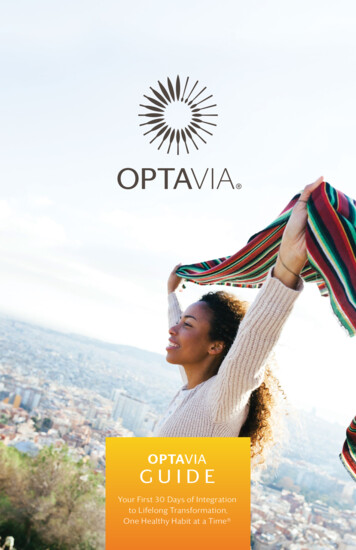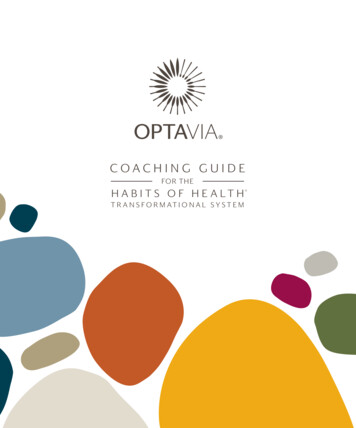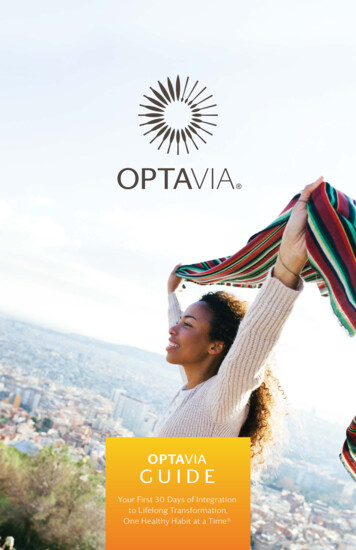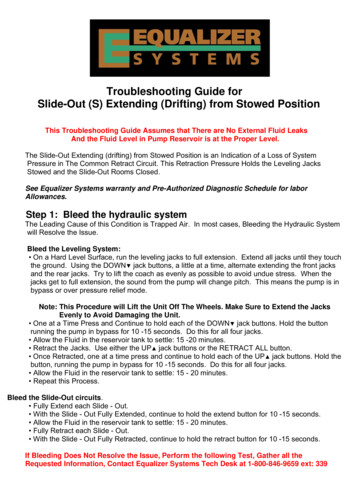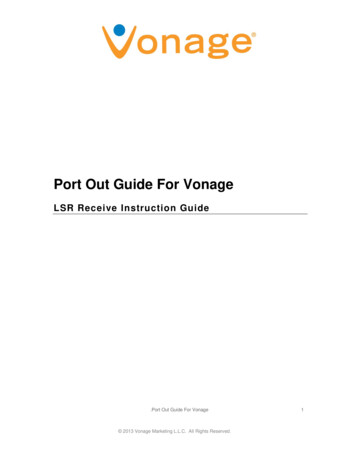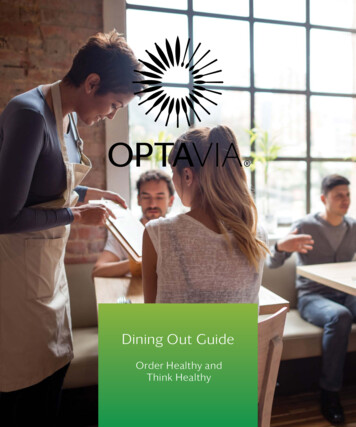
Transcription
Dining Out GuideOrder Healthy andThink Healthy
Table of ContentsLean & Green Basics . 5Beverages . 10Tips to Keep You on Track .12Healthy Celebrations . 18Healthy Ideas for Specific Cuisines .22Sit Down Restaurant Options .36Fast Food Restaurant Options . 68
you can have yourlean & green mealany time of day
Dining OutAt OPTAVIA , we believe you can live the best life possible and weknow that requires a healthy you. We also know that there will be timeswhen you are out with friends and family and need to make healthyeating decisions. This guide will empower you to make healthierchoices, whether you are dining out, picking up take-out after abusy day, or taking part in a special occasion. OPTAVIA’s RegisteredDietitian Nutritionists evaluated the menus of sit-down and fast-foodrestaurants and have selected items that fit the nutritional profile ofthe Lean & Green meal, so you can stay on track—whether you’re losingweight or maintaining your healthy weight.This guide also provides tips to help keep you on your path to optimalhealth and wellbeing while enjoying life. Each menu item is brokendown into categories: Lean, Leaner, Leanest, Green and HealthyFats. You may notice that the breakdowns don’t always match therecommendations on the lean options and green options lists.This is because the breakdown was determined based on a thoroughevaluation of the nutrition information, including the calorie, fat,carbohydrate, protein and sodium content.Remember:While this guide is designed to help you when you eat out, be sureyou’re doing so two or less times per week for a healthier life. Cookinghealthy meals at home is another positive way to bond with friendsand family!3
What is a Lean & Green Meal?A Lean & Green meal includes 5 to 7 ounces of cooked lean proteinplus three (3) servings of non-starchy vegetables and up to two (2)servings of healthy fats, depending on your lean protein choices.Enjoy your Lean & Green meal any time of day —whatever works best for your schedule.When you dine out, use the Lean & Green meal guidelines to guide yourchoices, particularly for menu items not included here.If you are dining out or tracking your intake, use the following Lean & Green MealNutritional Parameters to help guide your choices:Lean & Green Meal Nutritional ParametersCalories250 - 400Carbohydrates 20g total carbohydrate (preferably 15g)Protein 25gFat10 - 20gHealthy FatsEvery day, incorporate up to two (2) servings of healthy fats into yourLean & Green meal. Healthy fats are important because they help yourbody absorb vitamins like A, D, E and K. They also help your gallbladderwork properly.Lean & Green Meal: The "Lean"Lean Tips: Portion size recommendations are for cooked weight. Choose meats that are grilled, baked, broiled, or poached — not fried. Each week, try to eat at least two servings of fish rich in omega-3fatty acids (salmon, tuna, mackerel, trout or herring). Feel free to choose meatless options like tofu and tempehFor a complete list of meatless options, please refer to our'Vegetarian Information Sheet' or contact Nutrition Support atNutritionSupport@OPTAVIA.com.5
Choose the appropriate serving size of any protein from the list on thefollowing pages. We’ve sorted protein options into leanest, leaner and lean.All options are appropriate for OPTAVIA weight-loss plans; this just helpsyou make informed food choices.LEANEST: Choose a 7 oz. cooked portion andadd 2 Healthy Fat servings. Fish: cod, flounder, haddock, orange roughy, grouper, tilapia,mahi mahi, tuna (yellowfin steak or canned in water), wild catfish Shellfish: crab, scallops, shrimp, lobster Game meat: buffalo, elk, deer Ground turkey or other meat: 98% lean Turkey: light meat Meatless options: 14 egg whites 2 cups of liquid egg substitute or liquid egg whites 5 oz. seitan 1 ½ cups (12 oz.) 1% cottage cheese 12 oz. non-fat (0%) plain Greek yogurt ( 15g carb per 12 oz.) L EANER: Choose a 6 oz. cooked portion andadd 1 Healthy Fat serving. Fish: swordfish, trout, halibut Chicken: breast or white meat, without skin Ground turkey or other meat: 95% – 97% lean Pork chop or pork tenderloin Meatless options: 2 whole eggs plus 4 egg whites 2 whole eggs plus 1 cup liquid egg substitute 1 ½ cups (12 oz.) 2% cottage cheese 12 oz. low-fat (2%) plain Greek yogurt ( 15g carb per 12 oz.)6
LEAN: Choose a 5 oz. cooked portion andno Healthy Fat serving added. Fish: salmon, tuna (bluefin steak), farmed catfish, mackerel, herring Lean beef: steak, roast, ground Lamb Ground turkey or other meat: 85% – 94% lean Chicken or turkey: dark meat Meatless options: 15 oz. Mori-nu extra firm or firm tofu (bean curd) 3 whole eggs (up to two times per week) 4 oz. (1 cup) shredded reduced-fat or part-skim cheese(3 – 6g fat per oz.) 8 oz. (1 cup) part-skim ricotta cheese (2 – 3g fat per oz.) 5 oz. tempehHealthy Fat ServingsAdd 0 – 2 Healthy Fat servings daily based on your lean choices: 1 teaspoon oil (any kind)1 tablespoon regular, low-carbohydrate salad dressing2 tablespoons reduced-fat, low-carbohydrate salad dressing5 – 10 black or green olives1 ½ oz. avocado⅓ oz. plain nuts, such as almonds, peanuts or pistachios1 tablespoon plain seeds, such as sesame, chia, flax or pumpkin seeds½ tablespoon regular butter, margarine or mayonnaiseFor a complete list of healthy fat options,refer to our 'Condiment & Healthy Fat' list online.*Salad options listed are plain without dressings, croutons,and other higher calorie/carbohydrate options, unless otherwise noted.7
Lean & Green Meal: The "Green"Choose three servings from our Green Options list below for each of yourLean & Green meals. We’ve sorted vegetable options into lower, moderate,and higher carbohydrate levels. Each one is appropriate on our OPTAVIAweight-loss plans; the list helps you make informed food choices.Choose 3 servings from the Green Options List:1 serving ½ cup vegetables (unless otherwise specified)LOWER CARBOHYDRATE1 cup: collards (fresh/raw), endive, lettuce (green leaf, butterhead,iceberg, romaine), mustard greens, spinach (fresh/raw), spring mix,watercress, bok choy (raw)1 2 cup: celery, cucumbers, white mushrooms, radishes, sprouts (alfalfa,mung bean), turnip greens, arugula, nopales, escarole, jalapeño (raw),Swiss chard (raw), bok choy (cooked)MODERATE CARBOHYDRATE 2 cup: asparagus, cabbage, cauliflower, eggplant, fennel bulb,kale, portabella mushrooms, cooked spinach, summer squash(scallop or zucchini)1HIGHER CARBOHYDRATE 2 cup: broccoli, red cabbage, chayote squash, collard or mustardgreens (cooked), green or wax beans, kabocha squash, kohlrabi, leeks(cooked), okra, peppers (any color), scallions (raw), summer squash(crookneck or straightneck), tomatoes, turnips, spaghetti squash,hearts of palm, jicama, Swiss chard (cooked)1NOTE: All vegetables promote healthful eating. but on the Optimal Weight 5 & 1 Plan, we eliminatethe highest-carbohydrate vegetables (such as carrots, corn, peas, potatoes, onions, edamame, andbrussel sprouts) to enhance your results. Once you’ve achieved your healthy weight, we encourageyou to include ALL vegetables for long-term healthy eating.8
increase your health,confidence and vitality
BeveragesFollow the recommended beverage guidelines.Plain water is always appropriate; spruce it up with a lemon wedge andice or your favorite Flavor Infuser. Stick to calorie-free beverages, like dietsoda, unsweetened tea, coffee, sparkling water or sodium-free seltzer.AlcoholOPTAVIA does not recommend the use of alcohol for people in theweight-loss phase of the program, especially if you have diabetes.Not only does alcohol add empty calories, it promotes dehydrationand can decrease inhibitions, lessening one’s resistance to thetemptation of ordering unhealthy food.Further, alcohol’s effects on those following a reduced-calorie meal planmay be felt more rapidly and may increase the possibility of the relatedside effects of alcohol consumption.10
Tips to Keep You on TrackBefore Dining OutBe preparedWhen you know what optimal nutrition looks like, healthy eatingbecomes second nature. When a spontaneous dining opportunitypresents itself, you will know just what to do.Ask yourself: What will I do if someone gives me a hard time aboutmy choices? What will I do if I’ve never been to this restaurant before? What will I do if they have my favorite dish/dessert?By mentally “walking yourself through” the situations you’re likely toencounter at the restaurant, you’ll be better prepared to handle themwith confidence. With a little preparation, dining out is enjoyableand stress free.12
Research menusMost restaurants have menus online and some even publish thenutrition information of their dishes. If there’s no information onlineand the eatery is close, consider stopping in for an advance peek. Ifthe nutrition information is available, use our Lean & Green nutritionalparameters as a guide to making healthier choices.Lean & Green Meal Nutritional ParametersCalories250 - 400Carbohydrates 20g total carbohydrate (preferably 15g)Protein 25gFat10 - 20gLooking over the offerings in advance lets you take your time andmake careful, healthy choices. You’ll know what to order once you’reseated without feeling rushed or self-conscious. If you can’t findsomething that’s appropriate for your phase of the program, ask!Many restaurants are willing to accommodate simple requests forsomething within the Lean & Green meal guidelines.Just as you would not think twice about ordering something specialfor someone with food allergies or other dietary needs, you should feelconfident about inquiring about healthy choices. Remember, feelinggreat about your healthy choices is the goal.Pick good companionsSometimes who you eat with is almost as important as where youdine. The first few times you eat in a restaurant after starting yourOPTAVIA journey be sure your companions are supportive of you andyour endeavors. Soon, you’ll be comfortable enough to make the rightchoices, no matter the company.13
During the MealEat mindfullyBring all of your senses to the table. Take in the aroma of the food,notice the texture of the food on your tongue and really taste yourmeal. Experience each bite from start to finish. It typically takes thestomach 15 to 20 minutes to signal the brain that you’ve had enoughfood. Get the most out of every bite by eating slowly and give yourselfa chance to notice when you’re full.Watch your thinkingOur inner dialogue can get us into trouble when we experience worrythat refusing food or drinks will offend someone or call attention toourselves in a negative way.
Likewise, you might tell yourself that if you have one bite of dessert, it’sall over and you’ve blown it. Try questioning the helpfulness of thosetypes of thoughts.Ask yourself: Is this thought in any way useful or helpful? Does this thought help me take effective actiontowards my health? Does this thought help me to be who I want to be?If a thought is deemed unhelpful, let it go. After all, these are justthoughts and not some command you have to obey or rule youhave to follow. They can be allowed to come and go of their ownaccord without any need for you to hold on to them, push themaway or obey their command.Be assertiveIf someone pressures you to eat something you know isn’t in line withyour health goals, stand up for yourself. You have the right to be heardand don’t have to apologize or explain yourself to anyone. You canrespectfully communicate your wishes, thoughts and feelings and nothave to feel at the mercy of anyone who doesn’t understand. You cansay, “Thanks, but no thanks: I’m completely committed to healthyeating right now.”15
Dealing with Any UrgesBreathe deepOne of the easiest and most powerful ways to handle an unhealthyeating urge is to stop and take a few deep, cleansing breaths. Closeyour eyes and concentrate on slowly filling and emptying your lungsas your mind quiets down and you reboot your awareness. Open youreyes and continue enjoying yourself.Engage in the conversationIf you’re thinking obsessively about the food, switch gears. Try focusingon the conversation, being completely “in the moment” with yourdining companions; ask questions, listen intently and show them you’relistening by reflecting back what they’re saying. This is not only a goodway to take your mind off food but also an excellent way to practicegood communication skills!Talk it outTalking about your urges to eat with your independent OPTAVIACoach or someone who understands can provide relief. It is not asign of weakness or failure to have these feelings from time to time.Plus, your Coach can give you valuable support as you stick to healthychoices. No matter what you are facing, your Coach has likely been inyour very same shoes and can help steer you to success.16
“Urge surf”If you don’t feel comfortable talking it out and you can’t take yourmind off of food, then you can try opening up to those thoughts. Afood craving is like an ocean wave. It builds, crests, crashes gently ontoshore, and then fades away into the sand. As compelling as the urgeis, it’s temporary. If you can allow it to just be there and let it run itscourse, you’ll find the feeling passes within a few minutes.If all else fails Remember that you are on a journey to Lifelong Transformation, OneHealthy Habit at a Time . One slip-up or ill-advised indulgence will notruin your chances of long-term optimal health and wellbeing. If you falloff the wagon, treat yourself with compassion, reframe the experienceas a learning opportunity and get back on track right away. The idea isto prevent an unhealthy decision from becoming a complete relapseinto old, unhealthy eating ha
choices, particularly for menu items not included here. If you are dining out or tracking your intake, use the following Lean & Green Meal Nutritional Parameters to help guide your choices: Healthy Fats Every day, incorporate up to two (2) servings of healthy fats into your Lean & Green meal. Healthy fats are important because they help your body absorb vitamins like A, D, E and K. They also .
